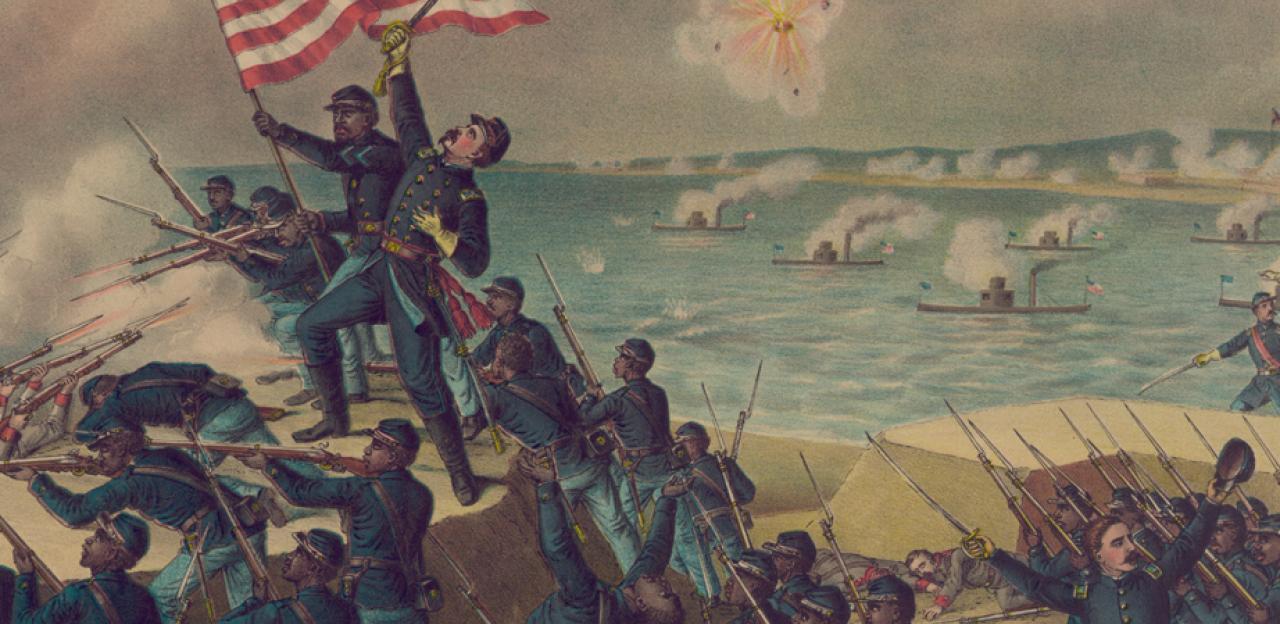Fort Wagner

The Battle of Fort Wagner
Battery Wagner, Morris Island
The city of Charleston, South Carolina, stood as a symbol to people in the north and the south throughout the Civil War. To many northerners, it was the symbol of secession. To many southerners, it stood as their birthplace of independence. While Charleston was an important port city before the war, its strategic importance after the firing on Fort Sumter was questionable. By 1863, a Union blockading squadron sat off of the coast, largely sealing off the harbor. The city lacked major industry to supply the south with goods and war materials, and it was situated far from the front lines of war. Yet, the fall of Charleston was always in the fore of Federal war planners even though Charleston Harbor was one of the most heavily fortified places on the continent.
After the successful amphibious operation against Port Royal, South Carolina, and the stunning, long-range artillery bombardment that led to the swift capture of Fort Pulaski, Brig. Gen. Quincy Gillmore was assigned to lead the 1863 campaign against the city of Charleston. Gillmore, who graduated first in his West Point class of 1849, was a rising star within the Union ranks.
Gillmore’s plan, supported by a heavy naval presence, was to seize Morris Island so he could place heavy rifled guns on Cummings Point that would, in turn, neutralize Fort Sumter. Once Sumter was reduced, the army and the navy could move swiftly to capture Charleston, the birthplace of the rebellion.
On July 10, Gillmore’s Federal soldiers crossed from adjacent Folly Island to the south and secured a foothold on the southern tip of Morris Island. The Confederate defenders held the northern portion of the island, which included the formidable earthen Fort Wagner, a stronghold created out of sand, earth, and palmetto logs.
A Federal assault on July 11 was easily repulsed by Wagner’s defenders. The undeterred Federals prepared for a new and better-coordinated attack upon Fort Wagner. The new plan included a close-range land and sea bombardment of the fort, followed by a land assault of some 5,000 soldiers.
Facing the renewed Federal onslaught were more than 1,620 Confederate soldiers under the command of Brig. Gen. William Taliaferro, a cast-away from General Robert E. Lee’s Army of Northern Virginia but an experienced leader nonetheless. Fort Wagner bristled with 14 heavy guns, mortars, carronades, and field pieces situated among a well-laid-out fortress, designed to withstand modern rifled artillery fire.
On July 18, Gillmore sent forward his Federal regiments. The assault was led by the 54th Massachusetts, a Boston regiment filled with free Blacks. As the Federal soldiers neared the fort, they were subjected to artillery and musket fire that shredded their exposed ranks. Despite their heavy losses, the remnants of the 54th Massachusetts reached and scaled the earthen walls of Fort Wagner. Descending into the fort, the 54th engaged in a bloody hand-to-hand struggle with the Confederate defenders only to be thrown back with heavy losses.
Subsequent assaults by the 6th Connecticut, 48th New York, 3rd New Hampshire, 9th Maine, 76th Pennsylvania, 7th New Hampshire, 100th New York, 62nd Ohio, and 67th Ohio pressed the hard fighting Confederate defenders to their limits, but failed to take the fort. The surviving Federal soldiers streamed back to their positions south of the fort late in the evening of July 18. Federal casualties reached 1,515, with the 54th Massachusetts losing 42% of its ranks in the attack. Brigadier General George Strong and three colonels, including the leader of the 54th Massachusetts, Col. Robert G. Shaw, were killed or mortally wounded in the attack. Light by comparison, Confederate losses numbered just 174 men.
After this bloody repulse, Gillmore’s men settled into their Morris Island positions for a lengthy siege that finally led to the Confederate abandonment of Fort Wagner on September 7, 1863—yet even after all of the effort and bloodshed, the Federals were no closer to securing Charleston.


